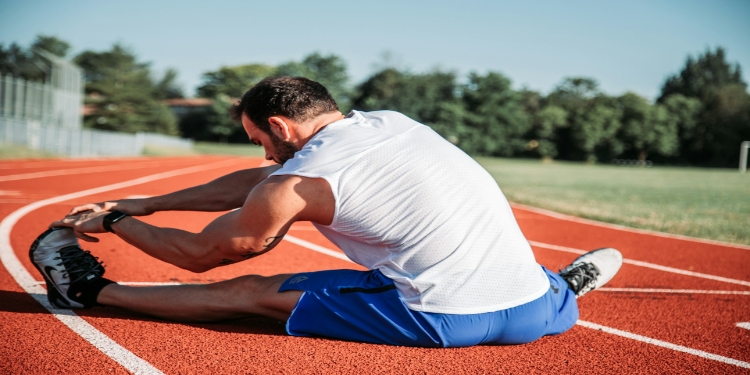Good posture is about more than standing tall. It affects how you move, how you feel and even how you breathe. When posture slips, the body has to work harder to stay balanced. Muscles tighten, joints ache and energy levels drop. Over time, poor posture can lead to back pain, neck strain and fatigue. Stretching is one of the simplest ways to correct these problems. It restores balance in the body and helps you move comfortably again.
Why Posture Matters
Posture is the foundation of movement. It determines how evenly weight is distributed through the spine, hips and legs. When posture is good, the muscles share the work evenly. When it is poor, certain areas are forced to compensate, leading to stiffness or pain.
Modern life makes good posture difficult to maintain. Long hours at desks, looking down at screens or driving can pull the shoulders forward and round the upper back. Sitting for too long also shortens the hip flexors and weakens the glutes. The result is tension and misalignment throughout the body.
Stretching helps correct these imbalances by lengthening tight muscles and releasing tension where it has built up. With regular practice, the body begins to hold itself naturally in better alignment.
How Poor Posture Causes Pain
When posture is poor, the body is out of balance. The muscles in the neck and shoulders become tight from holding the head forward. The chest shortens, and the lower back starts to take on extra strain. Over time, this leads to discomfort, headaches and fatigue.
Bad posture also affects how you breathe. A curved spine restricts the lungs, making breathing shallow. This limits oxygen flow and leaves you feeling tired. Stretching opens the chest and allows deeper breathing, which supports both physical and mental energy.
Even small changes in posture can make a big difference to comfort. Stretching gives the body the space it needs to move naturally again.
How Stretching Helps
Stretching works by releasing tension in tight muscles and improving balance between opposing muscle groups. When one side of the body is too tight, the other side has to work harder. Stretching restores that balance.
It lengthens shortened muscles such as the chest and hips, allowing the shoulders and spine to return to a natural position. It also strengthens weaker areas by improving their range of motion.
Stretching encourages awareness of how your body feels and moves. As flexibility improves, posture corrects itself naturally without effort. You start to notice when you slouch or lean, and the body knows how to reset.
The Benefits of Assisted Stretching
Stretching on your own can help, but assisted stretching takes it further. A trained professional helps guide your body through controlled movements so you can stretch more deeply and safely.
At stretched.uk, assisted stretching sessions are designed to address the areas most affected by poor posture. The therapist works on the chest, shoulders, hips and spine to release tension and restore balance.
Because the movements are guided, you can relax completely. This allows the muscles to release more fully than they would during solo stretching. Over time, the results last longer and posture improves naturally.
Assisted stretching also ensures safety. The therapist controls each movement and adjusts it to your comfort level. This prevents strain and helps you progress gradually without pain.
Everyday Habits That Affect Posture
Good posture is not just about how you sit or stand. It is shaped by the small habits you repeat every day. Looking down at your phone, sitting cross-legged or leaning to one side can all create imbalances over time.
Stretching helps undo these habits by bringing awareness back to your body. It trains your muscles to move evenly again and reduces the tension caused by one-sided movements.
In addition to stretching, try adjusting your workspace. Keep screens at eye level, rest both feet flat on the floor and take short breaks to move every hour. These small changes make a big difference to how your body feels.
Stretching for Pain Relief
Tension is one of the main causes of everyday pain. When muscles are tight, they pull on joints and limit movement. Stretching helps by releasing this tension and improving blood flow.
Gentle stretching can ease stiffness in the neck, shoulders and lower back. It also reduces the risk of muscle strain from sudden movement. Many people notice that regular stretching not only relieves pain but prevents it from returning.
For those dealing with chronic discomfort, assisted stretching at stretched.uk provides targeted relief. The therapist identifies where tension is coming from and uses guided movement to release it safely.
Posture and Energy
Poor posture does more than cause pain. It also drains energy. When your body is misaligned, it has to work harder to perform simple tasks. Muscles tire more quickly, and you may feel sluggish or mentally foggy.
Stretching helps by improving alignment and breathing. When the body is open and balanced, air flows more easily through the lungs and circulation improves. The result is more energy and a greater sense of vitality throughout the day.
People who stretch regularly often notice they stand taller and move with more confidence. This physical openness also improves mood and focus.
Building a Routine
To correct posture and stay pain free, consistency matters. Stretching once a week helps, but daily movement brings the best results. Even a few minutes each morning or evening can make a difference.
Start with gentle movements. Roll your shoulders, stretch your arms overhead and rotate your spine slowly from side to side. Open the chest by clasping your hands behind your back and lifting gently. Focus on slow breathing as you move.
Adding professional assisted stretching once or twice a week at stretched.uk helps deepen the results. Over time, your posture will feel more natural and movement will become easier.
Long-Term Benefits
Good posture improves every aspect of wellbeing. It reduces strain on the joints, improves circulation and supports better digestion and breathing. Stretching keeps the muscles balanced so the body can move freely without pain.
Long-term benefits also include greater flexibility, improved coordination and reduced stress. When your body feels open and balanced, it becomes easier to relax.
Assisted stretching can support you through all stages of progress. Whether you are correcting years of poor posture or maintaining good habits, it helps your body stay aligned and comfortable.
Conclusion
Modern life challenges posture in countless ways, but it is never too late to improve. Stretching helps the body find balance again, easing pain and restoring natural movement. It supports better breathing, higher energy and greater comfort in everyday life.
David Prior
David Prior is the editor of Today News, responsible for the overall editorial strategy. He is an NCTJ-qualified journalist with over 20 years’ experience, and is also editor of the award-winning hyperlocal news title Altrincham Today. His LinkedIn profile is here.














































































